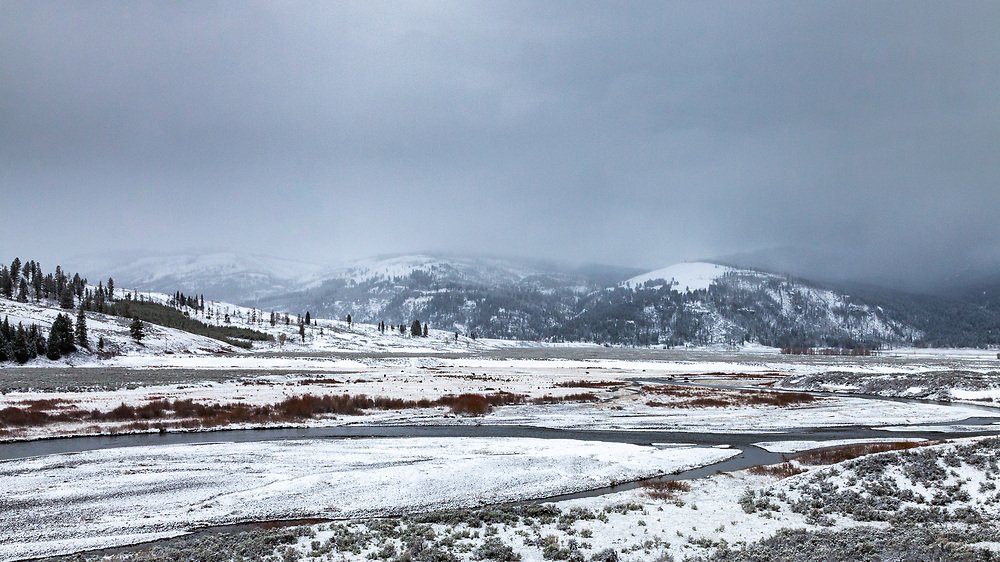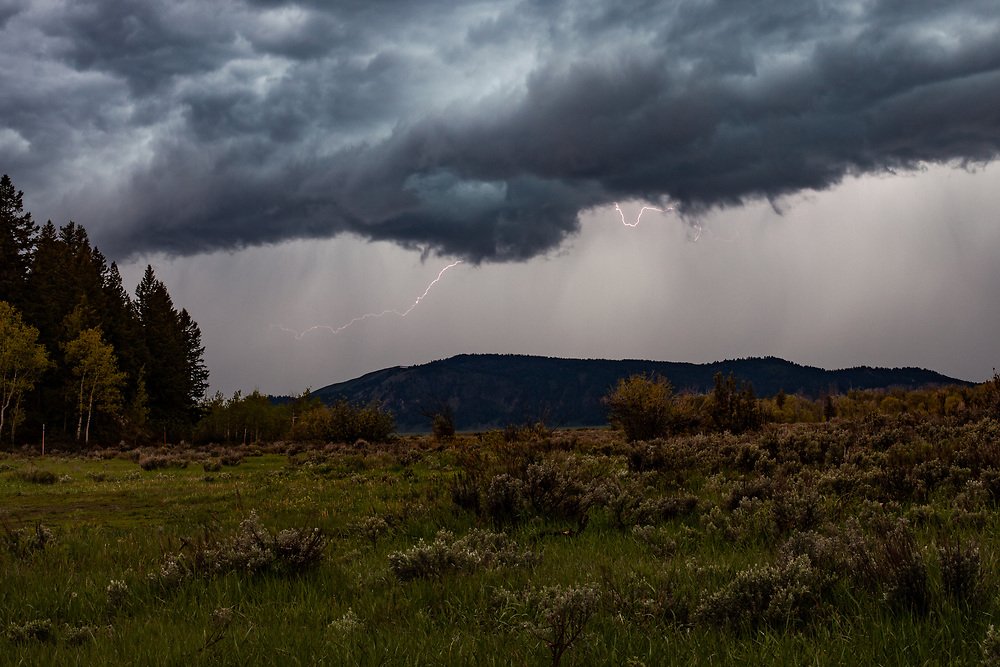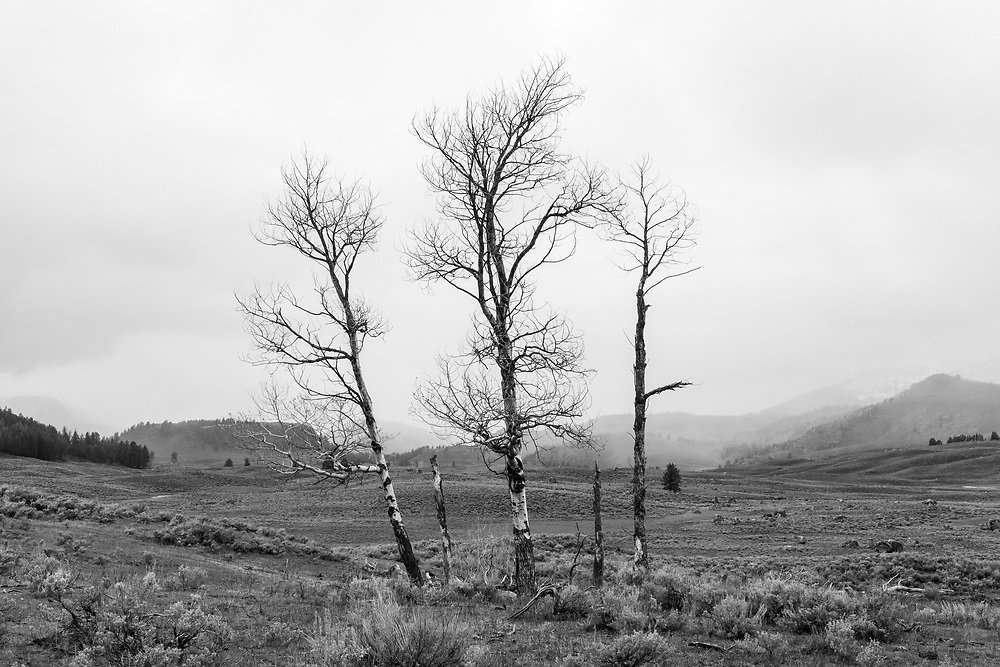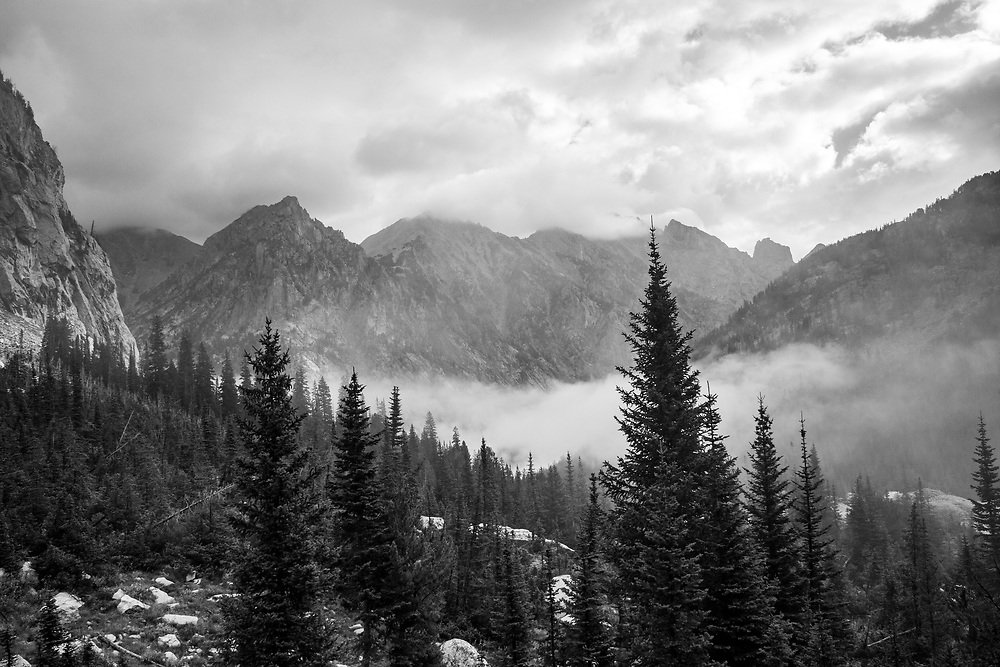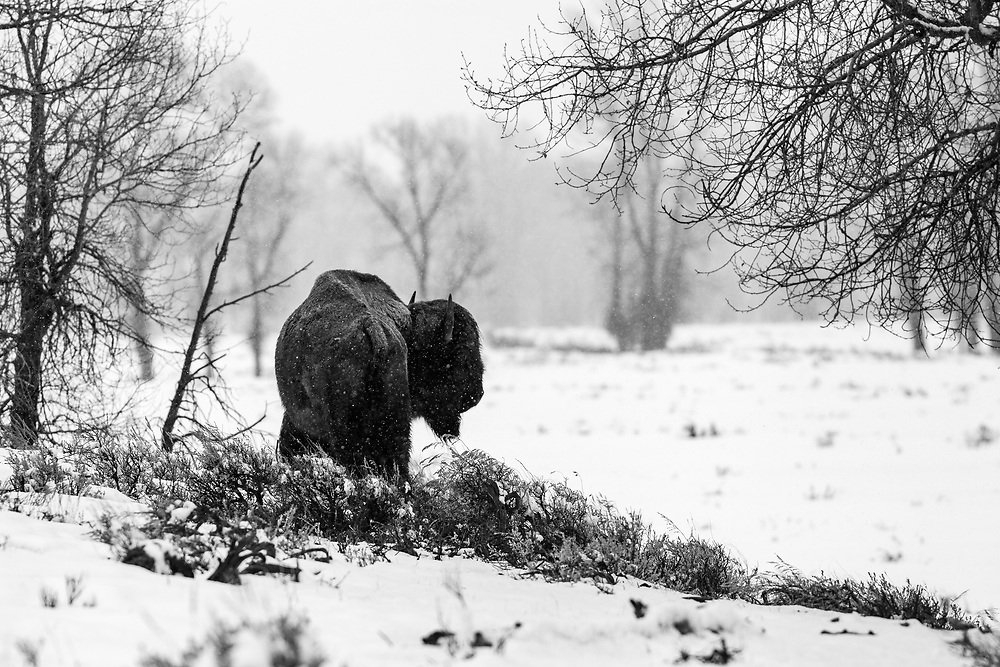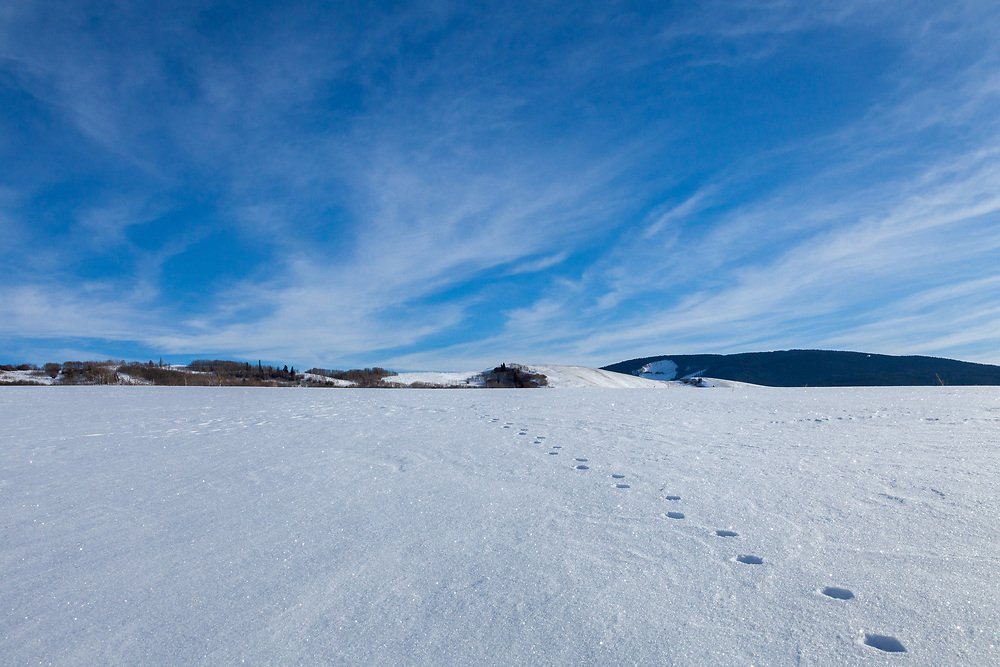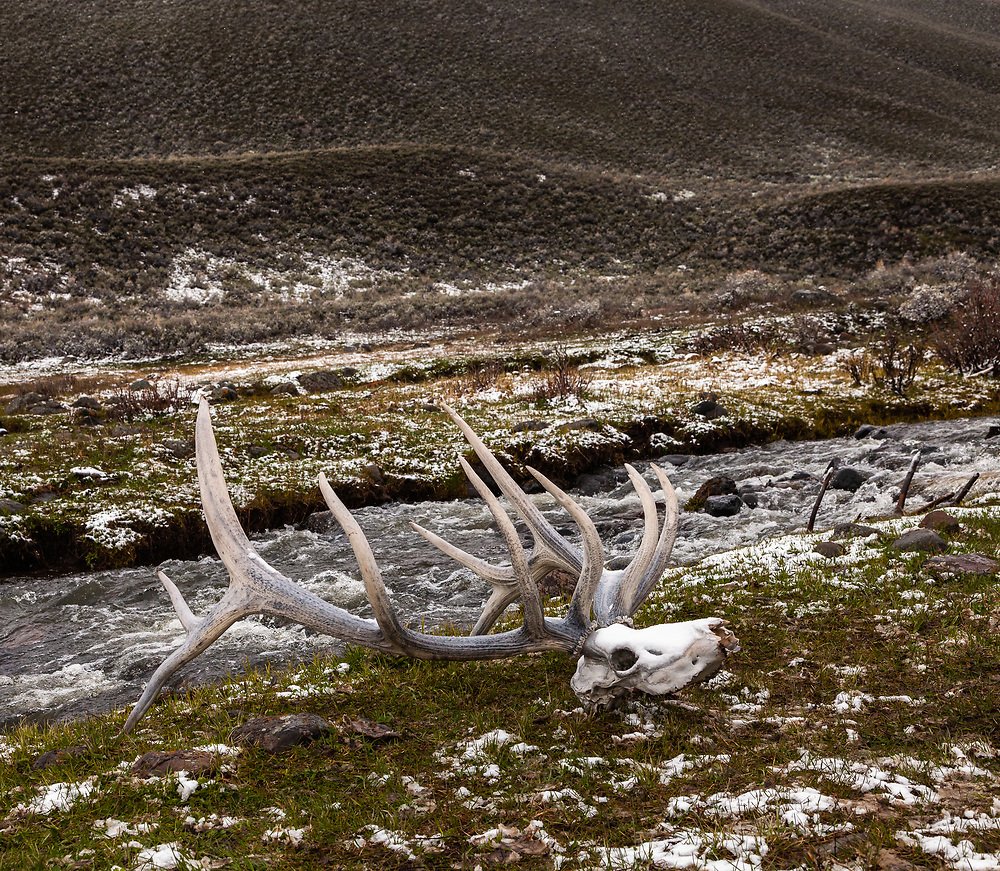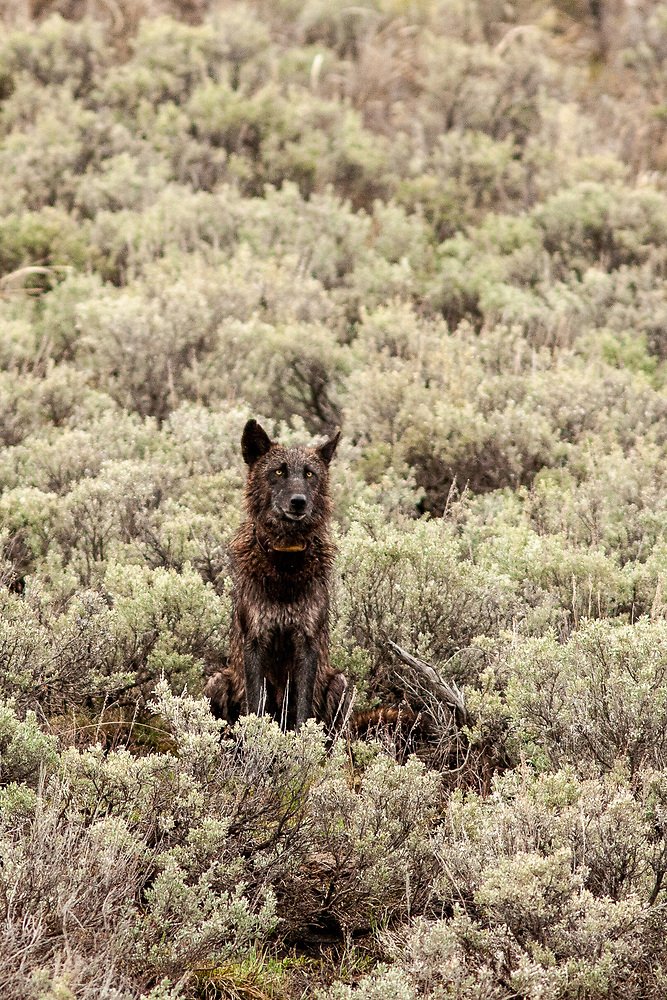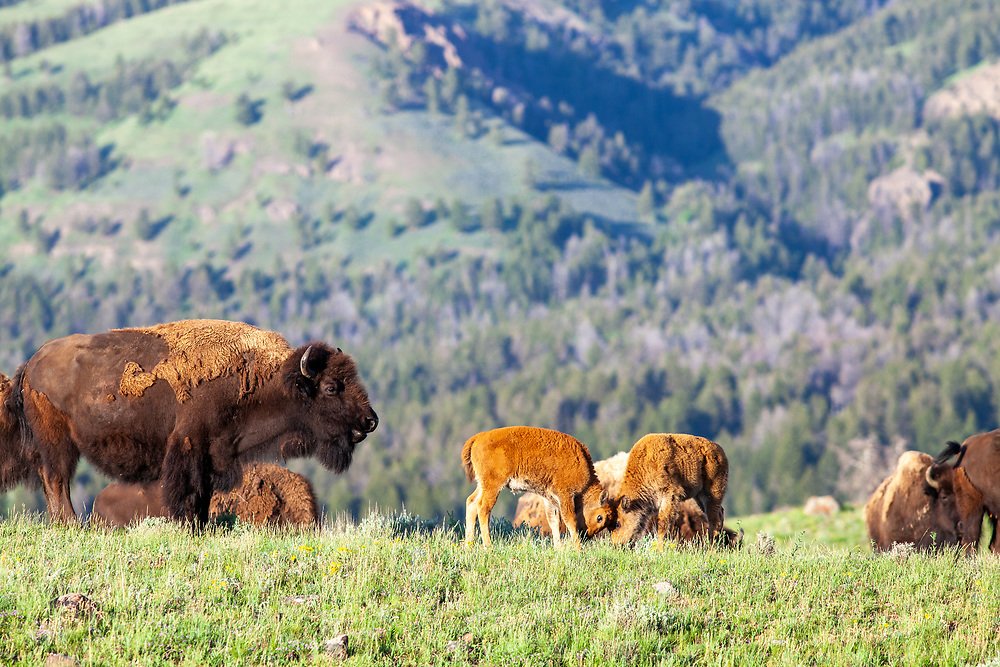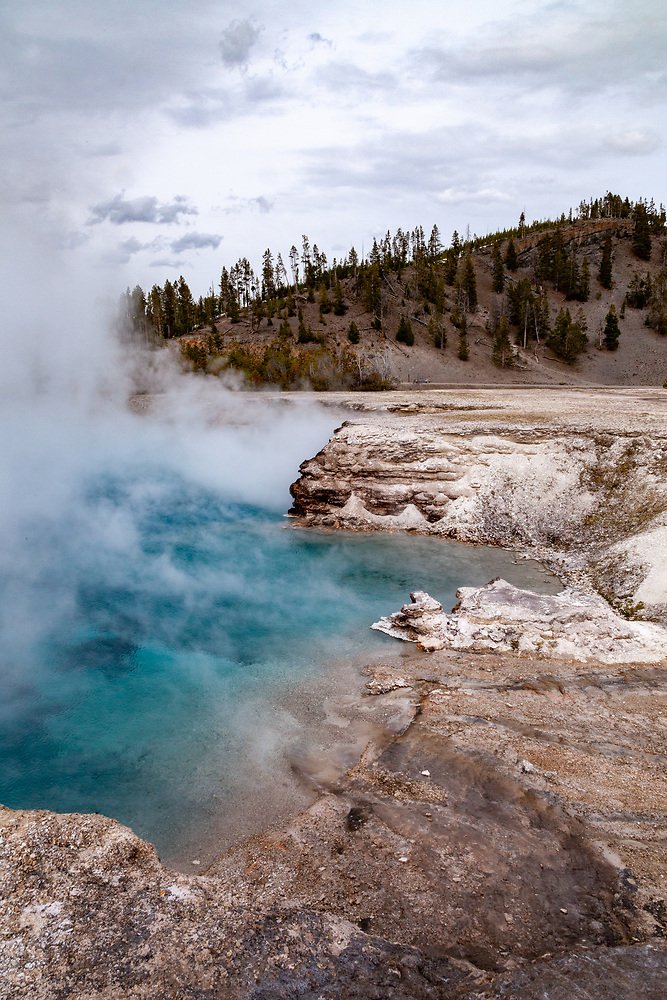Valley of the Wolves
The western ridge above Slough Creek glows with the rising sun. Bird song punctuates the shallow murmur of rushing water. As the valley awakens, eight wolves silently crest the ridge and descend into the valley. The alpha male is in the front of the pack, muscles rippling beneath his dense fur. Six yearlings trot close behind him in a single-file line.
The alpha female tails the group, a radio collar fixed around her neck. She is known by wolf biologists and Yellowstone National Park visitors as 926F, in accordance with a wolf tracking program that has been in operation since wolves were reintroduced to the Park on January 12, 1995.
Her fur is jet black and her eyes are honey-gold, and she is the leader of the Lamar Canyon wolf pack.
Down in the valley, perched above the banks of Slough Creek, a man hunches over a Swarovski spotting scope. His left eye squints shut and his right eye steadily tracks the single-file procession of wolves as they traverse the sagebrush steppe. A Yellowstone National Park patch is sewn onto the shoulder of his dark olive jacket, and his leather hiking boots are caked in mud. He has two radios strapped across his chest, and a radio telemetry receiver rests at his feet.
His name is Rick McIntyre–a wolf biologist for the Park–and every muscle in his body is tense with the knowledge that he is not the only one carefully tracking the pack’s every move.
An eerie silence settles over the landscape as the procession of eight wolves slinks across the valley. Their ears are held back and their tails are tucked. The Lamar Canyon pack is trespassing on Prospect Peak pack territory.
A challenging hunting season and bad luck has forced 926 and her mate to venture onto a rival pack’s land. The chance to make a kill and feed their yearlings comes at a high risk–the Prospect Peak pack is larger, stronger, and more experienced than their small family.
Through his spotting scope, Rick sees 926 stop short, sniffing the air with her nose raised to the slate-colored clouds above. She stands frozen, hackles raised in a sharp line from the scruff of her neck to the base of her tail.
In a blur of motion she whirls around and sprints back towards the ridge line, tail tucked beneath her legs. Her yearlings, trained well, follow closely on her heels. The seven wolves disappear over the ridge.
Rick swings his spotting scope back to the alpha male of the Lamar Canyon pack, known as 925. He’s easy to spot, with white, gray, and black fur standing out against the sagebrush steppe. The wolf stares calmly ahead, his entire body relaxed, as a pack of twelve wolves bursts out of the sagebrush and ambushes the lone wolf.
A weight settles across Rick’s shoulders and sinks into his stomach. The Prospect Peak wolves are racing across the valley, closing the gap with alarming speed. The lone alpha stands his ground, waiting.
As the wolves converge, Rick can visualize the outcome–a chase, a final struggle, the inevitable end.
In the moment before the wolves are upon him, 925 does something Rick never would have expected––the lone wolf charges towards the pack.
The action is too quick to track with a spotting scope. Alternating between binoculars and plain eyesight, Rick tracks 925 in a blur across the sagebrush steppe as he pushes speeds of thirty-five miles-per-hour.
Moments before colliding with the pack, 925 cuts to the side and skirts around the pack. The twelve wolves struggle to shift course, giving 925 precious seconds and a convincing lead.
Racing across the valley, the pack closes the gap.
The largest wolf of the pack, a male weighing in at 130 pounds, lunges at 925 and latches onto his flank. The remaining members of the pack converge on the tangled mass of canines. They tackle 925 and pull him to the ground.
Three minutes into the attack, a howl cuts across the valley. One of 925’s yearlings stands on the ridge, howling fiercely. Three of the attacking wolves give chase, disappearing over the ridge. Another howl erupts further down the ridgeline. 925’s largest and strongest yearling casts a dark silhouette against the sky as he howls, drawing three more wolves away from 925. A third yearling howls, and the last of the wolves give chase.
Rick scans the gray-green sagebrush, but can’t spot 925. Rick imagines the once sleek, gray body of the wolf now bloody, matted and torn, huddled under sagebrush branches.
The attack lasted five minutes.
Rick waits, listening. His job is to observe, to study–never to interfere or influence the events that he witnesses.
What feels to Rick like hours later, the Prospect Peak pack appears on the ridgeline and descends into the valley. The pack trots back towards the spot where they took down 925. Rick’s shoulders tense.
But when they reach the site of the attack, they look confused. 925 is nowhere to be found. After combing the sagebrush, the pack gives up the search––all except one yearling, jet black against the gray-green sagebrush.
The young wolf picks up a scent. Rick tracks him with his scope, and that’s when he sees him––the alpha male of the Lamar Canyon Pack is limping, with blood soaking through his coat and covering his face. The black yearling lunges for 925’s hind leg. 925 whirls around and nips the black wolf. The yearling tucks his tail under his body and flees. His energy waning, 925 limps away, disappearing into rolling hills and meadows of sagebrush.
His yearlings and mate would survive the night. He, however, would not.
Rick would later try to piece together 925’s motivations like a detective building an evidence board. Time after time, he landed on one explanation for the fearless charge against twelve wolves: 925 was protecting his family. The alpha wolf would rather sacrifice himself than risk leading the attacking wolves to his six yearlings and mate.
This was the same motivation that drove his mate, 926, to flee rather than stand and fight alongside 925. When 926 fled over the ridge, her yearling’s safety was not the only thing on her mind; she was pregnant. Her pregnancy is what spurred her and 925 to take on the risk of hunting in another pack’s territory in the first place. They needed to feed their soon-to-be-growing numbers, despite the risk of a conflict with the larger, more powerful Prospect Peak pack.
A few days later
Later that week, Rick was once again peering through a spotting scope, scanning for wolves. He had just picked up two radio collar signals from the hills above his location. 926 was the only remaining radio-collared wolf in the Lamar Canyon Pack. Two signals could only mean one thing–the Prospector Peak Pack had found her den.
His scope landed on 926 and three of her yearlings, where they were cowered against a cliff. Out of the trees, four dark figures approached. 926 began to yip, a vocalization that wolves only use when they are distressed. Her yearlings sprinted away from the approaching wolves, and 926 followed close behind.
Rick tracked 926’s movements with his radio telemetry receiver. He hiked back to his car and drove further down the road. The receiver beeped more rapidly as he approached.
Rick found 926 standing still on the edge of the road. Rick followed her gaze and his heart stopped. Across the road stood a 120-pound male from the Prospect Peak pack.
The alpha wolf of the Lamar Canyon pack was weak from nursing her pups and her yearlings were too young to help her hunt. In her current state she wouldn’t survive a fight with this wolf.
And so she cautiously began to wave her tail back and forth, tucking her ears back on her head.
After a tense moment, the massive male began to mirror her movements, wagging his tail.
926 trotted across the road, and when she approached him, she began to lick his face and paw at him with both front legs. Tails wagging, the Prospect Peak pack wolf turned and trotted away. 926 followed closely, and the male led her to three other members of his pack. She performed the same ritual for each of them in turn.
With their acceptance, 926 filled in the ranks of the Lamar Canyon Pack with the very wolves that killed her mate just days earlier.
The alpha female led the wolves to her den for a final test. The new members of the pack met and accepted the yearlings as well as the newborn pups.
Three of 926’s yearlings refused to accept the wolves that killed 925. They broke apart from the pack, forging out on their own.
Lamar Valley, a few weeks later
It’s a warm May evening for Yellowstone National Park, pushing 45 degrees Fahrenheit. I have my camera slung across my back, and I’m stooped over a spotting scope.
I’m tracking two wolves as they weave through the sagebrush. One wolf is jet black, and one is gray. They occasionally howl to one another. Both are former members of the Prospect Peak pack. Today, they are hunting to feed the mate, yearlings, and newborn pups of 925–the wolf they had killed just weeks before.
As the sun sinks below the horizon, painting the clouds pink, orange, and purple, the wolves forge across the Lamar River, cresting the hill and disappearing into the sagebrush where they return to the den, 926, and her pups.
Beneath a Teton Sky
Two Years Later
One mile outside Yellowstone National Park, November 2018
During a legal wolf hunt in November 2018, a hunter shot and killed 926 one mile outside the Yellowstone National Park boundary.
In an article published in Outside Magazine, “In Memory of Yellowstone Wolf 926F,” Rick reflects on the life and death of a wolf that he tracked during his career with the National Park Service.
“Wolf 926 was shot about a mile from my cabin.
“I found the site where she had bled out and collected some of her frozen blood. I trudged through the snow to where 926 had been born, and where I had seen her play with her pups, and left her remains there.”
“I did it for her family, but mostly I did it for her. She deserved to come back home.”
–Rick McIntyre, Wolf Biologist
Three years earlier
Lamar Valley, March 2015
On the evening of March 26, 2015, I stood with binoculars pressed against my cheekbones. I had my eyes fixed on two wolves in the valley below–926 and 925–who were feeding on an elk carcass on the edge of the Lamar River.
After filling her belly, 926 turned away from the carcass and trotted along the river towards the road. Her path brought her within 50 meters of where I stood. I watched, transfixed, as she crested the hill and disappeared into a thick sea of sagebrush.
In the valley below, 925 ate so much meat that his body was visibly swollen and bloated, his stomach stretched to the limit. He needed to eat and gain strength not only for himself, but also for his growing family.
Nestled on the hillside above the river, hidden beneath twisted sagebrush limbs, 926 was nursing six healthy wolf pups in her den. I was torn between watching 925 in the valley below and scanning the hillside for any sign of 926 and her pups.
As the sun dipped beneath the horizon, I spotted the alpha reemerging from her den. She trotted halfway down the hillside, perhaps 100 meters from where I stood, and sat on her haunches. Her ears perked forward, her gaze tracking her mate in the valley below. Soon her eyes began to scan the Lamar Valley, taking in her territory.
Her gaze landed on my own, her honey-golden eyes blazing bright in the fading light. A moment passed, an eternity.
926F, Alpha Wolf of the Lamar Canyon Pack
Slowly and deliberately, she shifted her gaze back to her mate in the valley below.
Soon her mate would return to the den, feed the pups, and give 926 a chance to return to the kill. They would take shifts, gorging themselves, until they had stripped the carcass clean.
Worried that my presence might be altering their behavior in some way, I reluctantly headed back to my campsite. I fell asleep with honey-golden eyes haunting my thoughts, mesmerizing in their piercing glow.
About Rick McIntyre
Rick told me the story of 926 and her mate as we stood in the heart of wolf territory on a cold and blustery spring day in Yellowstone National Park. We had been watching for wolves since the predawn hours, though the radio telemetry equipment remained quiet and we hadn’t seen any signs of wolves yet. I gazed out upon the Lamar Valley, watching a herd of bison move across the landscape as he described a story that would etch itself deep into my memory.
This story is one of thousands of wolf interactions that Rick has observed in the Park. He started tracking and observing Yellowstone’s wolves in 1995 when they were reintroduced to the Park after being extirpated by the U.S. government in 1926.
He served as a naturalist and wolf researcher for Yellowstone National Park through early 2018. Even though he’s retired, you’re just as likely to find him on the side of the road, hunched over a spotting scope, watching the wolves.
Through blizzards, thunderstorms, extreme cold, and sweltering heat, Rick has lugged his spotting scope and tracking equipment from corner to corner of the 3,472 square-mile expanse that makes up Yellowstone National Park. Each of Rick’s recorded observations helps contribute to our understanding of these secretive creatures, and helps us craft more informed management practices.
Rick’s observations of wolf dynamics aren’t always as intense as the story of 926 and the Lamar Canyon pack. Some of his stories are playful or joyful–wolf pups exploring a new world, yearlings learning to hunt as a pack, or star-crossed mates unifying rival packs.
When Rick retells the story of 926 and her fated mate, a weight settles over his audience. His already ruddy cheeks deepen to a darker shade of red, and his eyes glisten with the weight of his experience. Perhaps the group is gathered around a smoldering fire. Perhaps they are huddled on the roadside, scanning the sagebrush for a trace of a wolf. Regardless of where Rick tells the story, it always begins with the same opening scene.
A sprawling sagebrush steppe, a looming ridgeline, and eight wolves descending into the valley of a rival pack…


